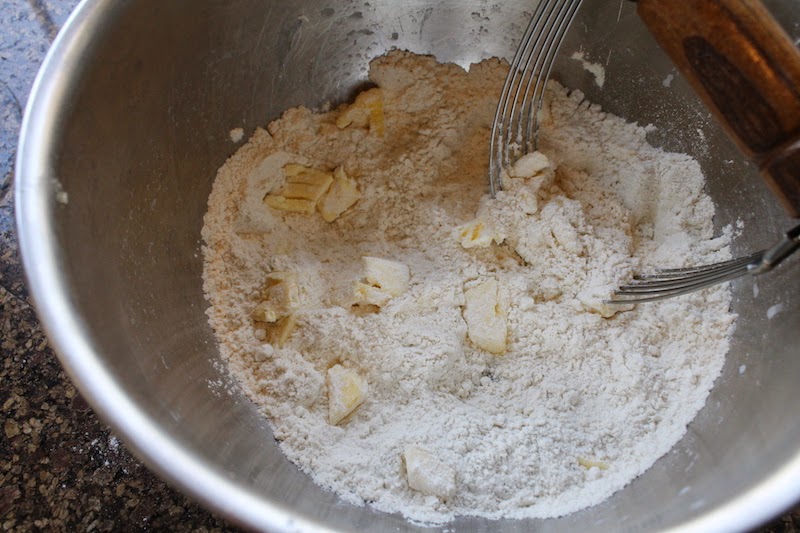This month’s Creative Cookie Exchange ingredient is ginger so I did something I’ve been wanting to do since a year ago April. I added some crystallized ginger to my friend, Jamie’s traditional French séches recipe, from over at Life’s A Feast and then, for good measure, sprinkled some ginger sugar on top. Divine! Perfect for getting into the Christmas spirit.
If you are ready for some gingerful baking, make sure you scroll on down to the bottom to see what the rest of the Creative Cookie Exchange bakers have for you, along with our fearless leader, Laura from The Spiced Life.
Ingredients
For the cookie dough:
Scant 1 cup sifted flour (sifted before measuring) or 120g plus extra for kneading and rolling
1/4 cup or 50g sugar
25g or a small handful of crystallized ginger pieces
2 3/4 tablespoons or 40g chilled unsalted butter (by which I mean straight from the refrigerator)
Pinch salt
1 large egg yolk
1/4 cup plus 2 tablespoons or 100ml heavy cream
For the ginger-sugar:
1 teaspoon ground ginger
2 tablespoons sugar
Method
Preheat the oven to 400°F or 200°C.
In a small bowl, mix together your ginger and sugar to make the ginger-sugar. Set aside.
Mince your crystallized ginger with a sharp knife or put it in a food processor to chop it up finely. The ginger gets really sticky when cut so the food processor is easier, if you have one.
Combine your flour and sugar for the dough in a mixing bowl and add in the cold butter, cut into cubes. Use a pastry blender to cut the butter into the flour, working quickly, until you have a sandy texture. You might still see some small bits of butter and that’s fine. That where the flakiness will come from when they bake, kind of like rough puff pastry.
Add the crystallized ginger bits to the flour mixture and use your fingers or the pastry blender to separate the sticky bits from each other and coat them with flour.
Add in the salt and the egg yolk and mix thoroughly with a fork.
Add in the cream and mix until you have a soft dough.
Scrape the dough out onto a clean surface sprinkled with flour and knead it for a few turns, until it is smooth and homogeneous.
Flour your rolling pin and a large piece of baking parchment and place your dough ball in the center with another light sprinkling of flour.
Roll the dough out into a large circle, about a 1/4 inch or 7mm thick.
Slide your parchment with the dough onto a cookie sheet and dust the circle liberally with ginger-sugar.
Gently cut the circle of dough into triangles with a knife.
Sprinkle on any remaining ginger-sugar.
Bake your cookies in your preheated oven for about 10-12 minutes or until puffed and set.
Remove from the oven and allow to cool for just a few minutes. While they are still warm, use your knife to separate the triangles again. Allow to cool completely.
Enjoy!
Bake some ginger cookies and your whole house will smell like Christmas is coming, I promise! I hope this wonderful link list will inspire you.
- Buttery Ginger Shortbread Cookies from Karen’s Kitchen Stories
- Chewy Ginger Cookies from Spice Roots
- Chocolate - Ginger Chewies from Baking in Pyjamas
- Favourite Gingerbread Cookies from What Smells So Good?
- Ginger Chocolate Ninja Cookies from NinjaBaking
- Ginger Curry Sugar Cookies from The Spiced Life
- Ginger Lemon Sandwich Cookies from Sweet Cinnamon & Honey
- Ginger Molasses Cutout Cookies from Magnolia Days
- Ginger Sour Cream Cookies from Basic N Delicious
- Oat, Orange and Ginger Crisps from Made with Love
- Orange Ginger Cookies from Indian Curries/stew
- Pepparkakor - Swedish Ginger Cookies from A Baker’s House
- Séches aux Gingembre from Food Lust People Love
- Vegan Ginger Cookies with Cardamom from Hezzi-D’s Books and Cooks
If you are a blogger and want to join in the fun, contact Laura at thespicedlife AT gmail DOT com and she will get you added to our Facebook group, where we discuss our cookies and share links.
You can also just use us as a great resource for cookie recipes--be sure to check out our Pinterest Board and our monthly posts. You can find all of them here at The Spiced Life. You will be able to find them the first Tuesday after the 15th of each month!







































